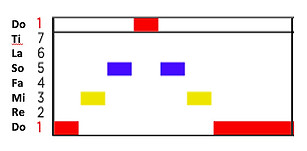for the 21 Praises to Tara, and other texts
This site uses visual tools from 'HookTheory' - a system developed by three MIT engineers to help people learn music in a more intuitive way.
This diagram shows the major scale - the most common scale in Western music.

-
The colours correspond to note pitches, and the length shows their duration.
-
The 'bars' are divided up to show the rhythm - here the beat is in three (as in 'one, two, three; one, two, three').
-
The notes are also labelled according to the 'solfa' or 'solfege' system (the 'do re mi' from the Sound of Music) and their position number or ‘scale degree’.
Words and images can be useful hooks for your memory when you are trying to learn the pattern of notes in a melody or harmony.
Using the solfa names or number names for the low part of the main slow tune sounds like this:
_edited_edited.jpg)
why would I care what an octave is?
if you look at the colours and labels on the scale above, you might notice there are eight notes, but the numbers only go from 1 to 7, and red note appears twice. This is because the 8th note, which is pitched what is called an ‘octave’ above the first note, starts the same pattern over again.
When two notes are an octave apart they basically sound like the same note – for example, when men and women sing the same tune together, men generally sing it an octave lower than the women, but it still feels like everyone is singing the same tune.
Why do they sound the same? Because the higher note vibrates twice as fast as the the lower note, so their vibrations are synchronised half the time (which is a lot). Notes with vibrations that synchronise in simple ratios like 3:2 or 5:4 also sound quite harmonious, but apart from singing on exactly the same note, singing notes an octave apart is as harmonious as you can get.
Any two notes an octave apart will have the same feel. This means the top red note functions in the same way as the bottom red note.
All the notes in the scale do different things. For example, the red note has a sense of landing or coming home - it feels natural to go back to it. But if you listen to the pink note, it feels unstable, like it really wants to move to the red note.
The patterns of notes in the major scale are the same regardless of what pitch you start - what is important is the way the notes relate to each other - their 'relative function'.
If you want to know more about about how notes function and why some notes sound harmonious when they are played at the same time (and others don't), you might find this youtube clip interesting:
what use is a tonic triad?


Another useful pattern to know is the 'tonic triad' or 'chord':
do-mi-so-mi-do or 1-3-5-3-1.
It is probably already familiar to you: it's that singer-warming-up sound.
All the 21 Taras tunes start from the notes of the tonic triad or chord.
The pattern is built on the foundation note or ‘tone’ of the scale, which is also known as the ‘tonic’ or ‘key note’ (red/do/1st note).
Knowing this pattern may help you find starting notes for the harmonies from whatever pitch the chant leader starts the melody.
It doesn’t matter what pitch the chant leader uses because, as with the major scale, the relationship between the notes is the same.
The bottom picture is the triad plus the first note of the scale up the octave.
You can hear that when all the notes of the chord are played together (with the individual notes played over the top), it sounds harmonious.
If you got interested in the theory - the triad includes the next two most consonant harmonies of the scale after the octave – the 5th (blue), and major 3rd (yellow), they vibrate in the simple ratios 3:2 and 5:4, which is why they sound harmonious.
more tips to find starting notes
You may find knowing the tonic triad is not enough, because the middle part that the chant leader would usually do does not always start on the red note (the tonic).
But there are lots of other familiar musical patterns you can fall back on:
starting notes for the fast tune
For the fast tune the chant leader starts on yellow (mi/3rd),
-
To get to the blue note for the high part (so/5th) from hearing the yellow note, think of the first two notes of the famous Brahms lullaby, or Greensleeves.
-
To get to the red note for the low part (do/1 or the tonic) from hearing the yellow note, think of the first two notes of 'Swing low, sweet chariot' or 'Shoo fly, don't bother me'.


starting notes for the slow tune
For the slow tune the chant leader starts on blue (so/5th).
-
It's easy to get to the red note (do/1) for the high part because it is the second note of the melody, but you could also think of the first two notes of 'Here comes the bride', 'Amazing Grace', 'Auld Lang Syne', or even 'da dah'!
-
To get to the yellow (mi/3rd) note from hearing the blue note think of the first two notes of 'This old man', 'Hey Jude', or 'Frosty the snowman'.
Learn how the transitions sound


Another way is to learn a pattern that starts off singing the chant leader's line and then diverts into the harmony line - most of the harmonies overlap with the middle line at some point, so you can just wait for the melody to lead you there!
For example, the transition from the middle part to the low part of the main slow tune would look and sound like this:
.jpg)
